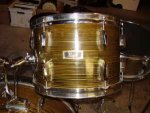willieboy_sf
Senior Member
I have a question about a vintage 1960's Pearl drum kit that is for sale locally. I know about the level of quality of the Japanese "stencil" kits that were made back in the 60's and early 70's, but what about kits that are badged "Pearl" from that era? Are they better than the stencil kits, or about the same, or is there no way of knowing without inspecting and playing the kit? Here is a photo. Any help is much appreciated.


